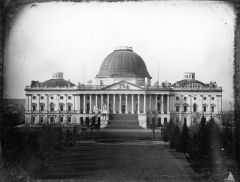Successfully balancing these responsibilities is a high priority for the AOC and can only be achieved through the dedication of talented professionals and crafts persons who consistently deliver innovative solutions to preserve our environment and the buildings under our care.
Sustainability has always played a role at the AOC. When construction on the Capitol building first began in 1793, a future-oriented vision ensured designing and building for permanence through the use of durable, local materials capable of lasting 100 years or more. Projects designed and completed today continue to embody this philosophy of “building for the ages,” while meeting the expectations of modern comfort, practicality and utilizing smart technologies. The AOC maintains, rehabilitates, renovates and modernizes existing structures to the greatest extent possible, always working to maintain the delicate balance between preservation and modernization.
As a national leader in sustainable and responsible practices, the AOC understands that historic preservation – the most sustainable of the building arts – and stewardship are powerful tools to drive the accomplishment of sustainability goals, overall energy and water savings and a high return on investment. This approach distinguishes our work and ensures that we create value through transparent, results-oriented initiatives.
Serving the dual functions of sustainability and historic preservation can pose some limitations on what can be achieved in energy and water conservation. However, progressive strategies and measures have been successfully implemented to achieve energy reduction objectives. Benchmarking and engineering evaluations lead to informed restoration and rehabilitation of facilities and plans that are harmonious with preservation.
The program to make the Capitol more energy efficient stresses environmental significance, cost-savings and delivery of improved services for constituencies. The AOC prioritizes projects through a standardized process that assesses a project’s urgency, type and importance for preservation of historic resources, regulatory compliance, mission accommodation, economics, physical security, energy and water efficiency and environmental quality. Before submitting budget requests for projects, the AOC classifies and prioritizes projects and annually evaluates funding requirements for developing its portfolio of projects and meeting project-specific needs.







